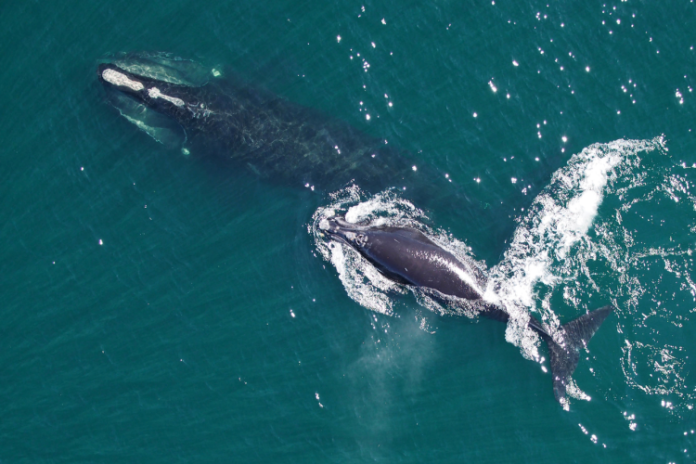
Federal regulators on Wednesday withdrew proposed changes to vessel speed limit rules intended to reduce the number of boat strikes suffered by the endangered population of North Atlantic right whales.
That will leave in place the current rules, while garnering praise from lawmakers and the fishing and boating industries, along with criticism from conservation groups.
There are approximately 360 individual North Atlantic right whales remaining, including fewer than 70 reproductively active females, according to the National Oceanic and Atmospheric Administration.
NOAA Fisheries says the species has experienced an ongoing Unusual Mortality Event since 2017, which includes sub-lethally injured or ill, seriously injured, and dead right whales.

Vessel strikes are considered the primary threat to right whales because they spend a lot of time at or close to the water surface, and they are difficult to spot from a boat due to their dark color and lack of a dorsal fin.
To reduce the risk of collisions, most vessels 65 feet or longer must travel at 10 knots or less in designated waters along the U.S. East Coast at certain times of the year.
That includes an area up to 20 nautical miles off the mouth of Chesapeake Bay, Cape Lookout and Beaufort Inlet, and from Wrightsville Beach southward, between November 1 and April 30 when right whales are migrating and calving.
NOAA Fisheries also institutes voluntary speed zones elsewhere in coastal waters when there are visual sightings of three or more right whales within a discrete area, or their presence is detected using acoustical devices.
The program notifies vessel operators to slow down to avoid right whales, provides maps and coordinates to vessel operators indicating areas where right whales have been detected.
For a period of 15 days after a whale is detected, mariners are encouraged to avoid these areas or reduce speeds to 10 knots or less while transiting.
Several voluntary slow zones were implemented earlier this month off the Outer Banks that expired this week.
The proposed changes announced in August 2022 included expanding the 10-knot speed restriction to include all vessels 35-feet and longer, and stretched from northern Florida to the Northeast U.S. for up to seven months of the year, and introduced mandatory speed zones where right whales were detected.
After receiving approximately 90,000 public comments, the National Marine Fisheries Service cited insufficient time to finalize the regulation under the Biden Administration as the primary reason for withdrawal.
“For over two years, I fought vigorously against the Biden Administration’s unscientific and ridiculously burdensome North Atlantic Right Whale Vessel Strike Reduction Rule,” said N.C. Third District Congressman Greg Murphy (R).
“Eastern North Carolina understands the importance of being good stewards of our environment while utilizing our God-given resources to help grow our economy and provide for our families,” Murphy said. “This is a tremendous victory for our fishermen, boaters, and countless businesses in our coastal economy who would have been devastated if this rule went into effect.”
Murphy said expanded compliance of the mandatory 10-knot speed restrictions in Seasonal Management Areas would result in 121,061 additional transit hours annually.

Along the eastern seaboard, nearly 16,000 vessels, 810,000 jobs, and $230 billion in economic activity would have been impacted, according to Murphy.
“ASA is happy to see the draconian vessel speed rule sent back to NOAA so that we can find a collaborative, long-term solution that effectively mitigates the potential for vessel strikes and incorporates innovative safety technologies,” said Mike Leonard, vice president of government affairs at the American Sportfishing Association.
“We look forward to working with the Trump Administration, Congress, and other stakeholders to protect North Atlantic right whales, anglers, boaters and the $230 billion sportfishing industry,” said Leonard.
“A plethora of better technologies are available today that should be utilized to protect right whales without negatively impacting fishing, boating, and shipping,” said Jason Schratwieser, President of the International Game Fish Association. “The IGFA and our partners have fought hard to protect our coastal economies, and we are committed to working with the next administration on better ways to ensure right whale populations recover.”
“This is a huge step forward for American boat manufacturers, coastal economies and outdoor enthusiasts across the U.S.,” said Frank Hugelmeyer, president and CEO of the National Marine Manufacturers Association.
“As we’ve said all along, NOAA’s proposed rule relied on incorrect assumptions and questionable data, and failed to distinguish between large, ocean-crossing vessels and small recreational boats, which could not be more different from each other,” Hugelmeyer said.
“While we waited over two years for a decision on the vessel strike reduction rule, our East Coast has become a graveyard for North Atlantic right whales,” said Gib Brogan, campaign director for the conservation group Oceana.
Brogan emphasized the urgency of the situation, warning that bureaucratic delays could lead to the first large whale extinction in U.S. waters in centuries.
“The Trump administration must find a solution that keeps fisheries on the water, sustains the marine economy, and supports the recovery of the North Atlantic right whale,” added Brogan.
A NOAA Fisheries statement said the agency “will continue to work closely with our partners and stakeholders to further efforts to conserve and rebuild the North Atlantic right whale population, including by using existing management measures and technological innovation and partnerships to help reduce the risk of vessel strikes.”









